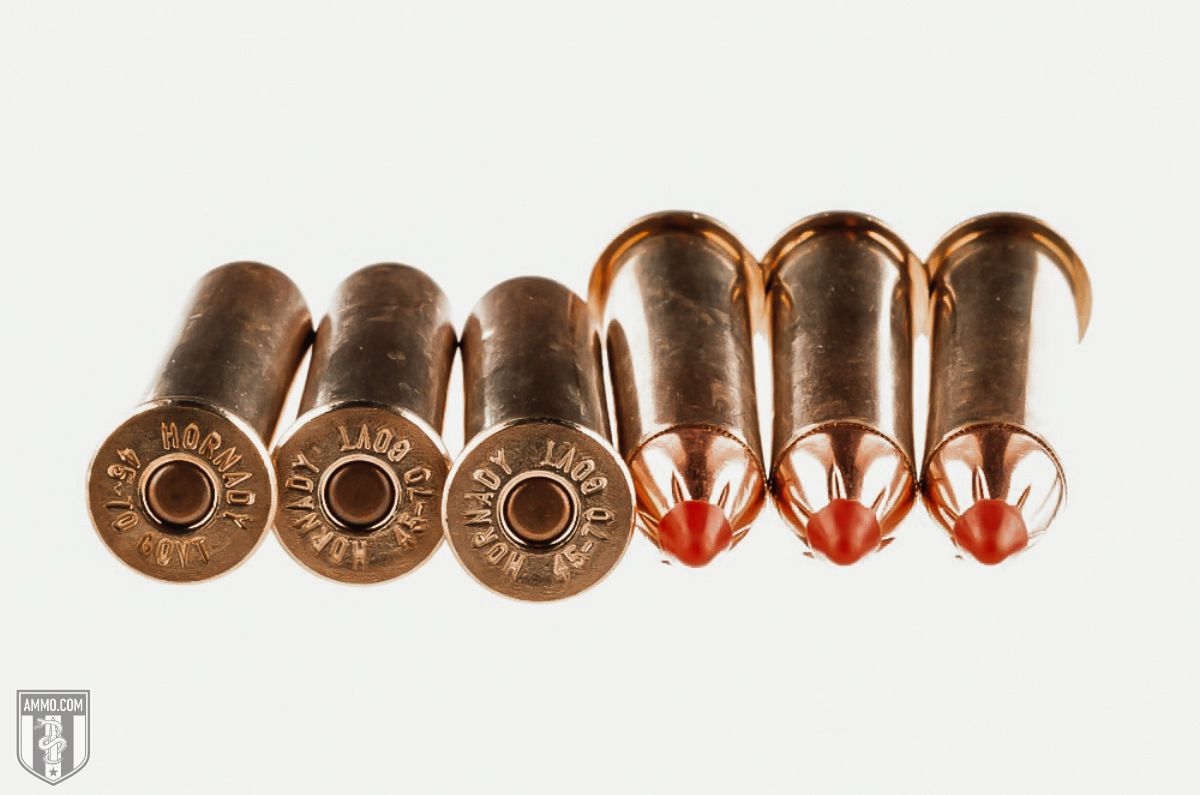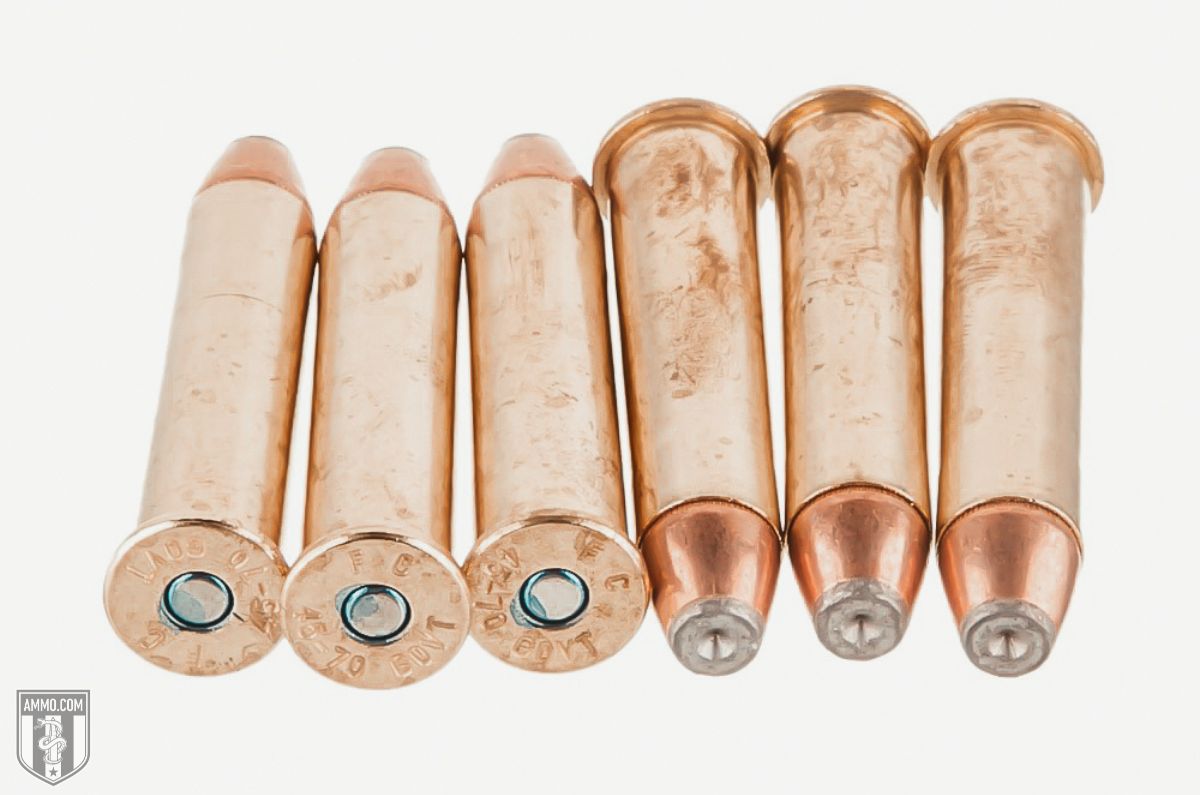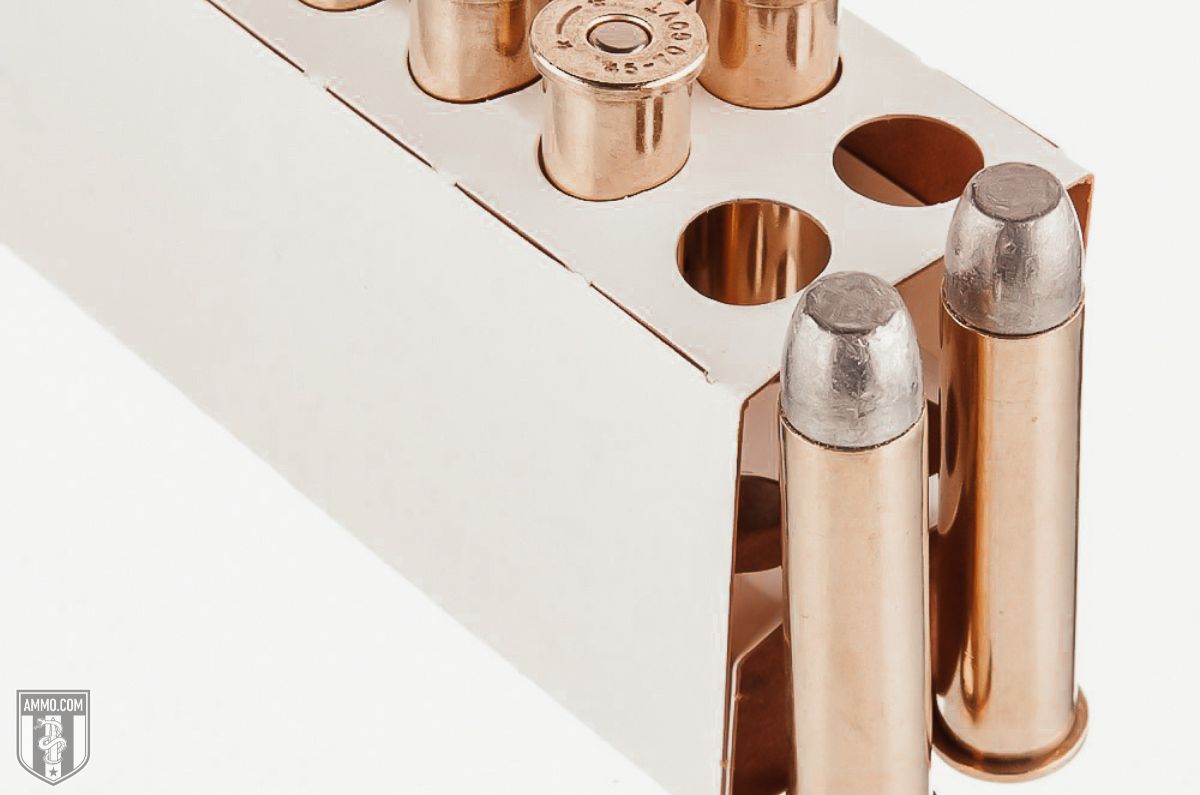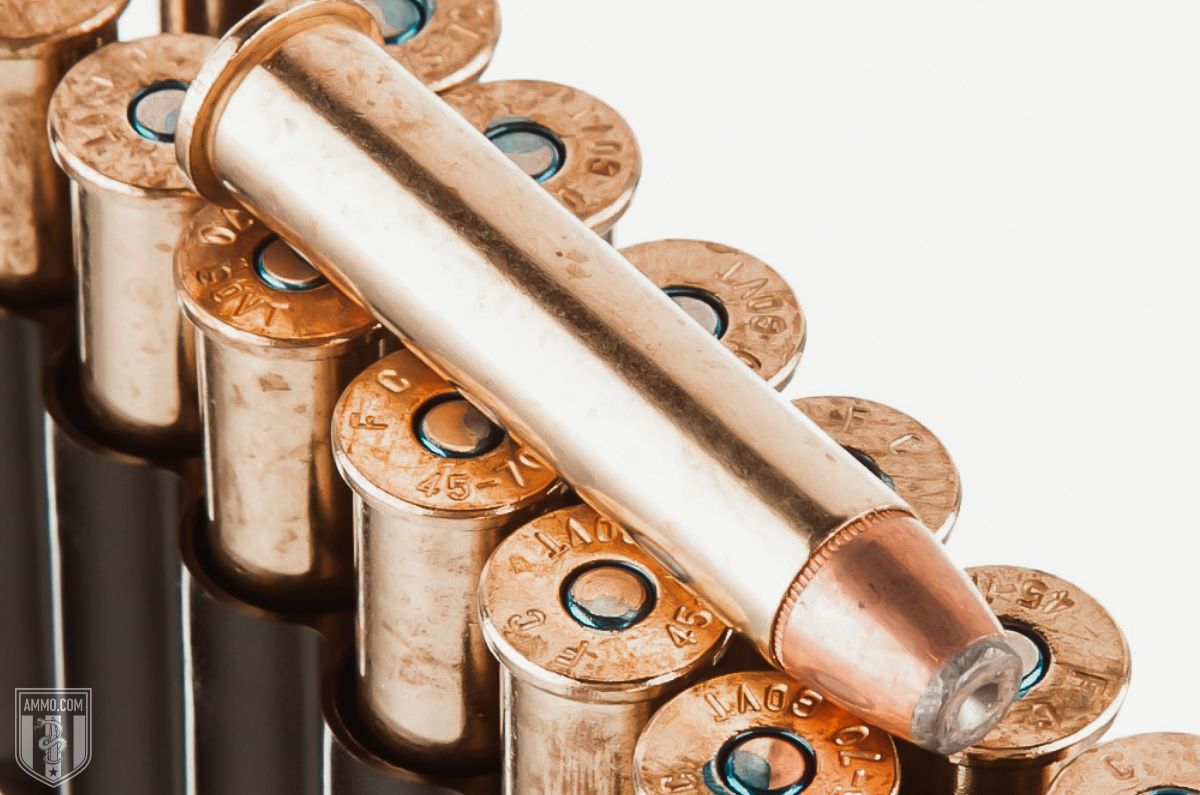450 Marlin vs. 45-70: Is the Modern Cartridge Always Better?

Recognizing an opportunity to modernize the 45-70, Marlin teamed up with Hornady to release the 450 Marlin in 2000. The 450 Marlin was designed to mimic 45-70 ballistics, but also to handle higher pressures that would have destroyed older 45-70 rifles.
The 450 Marlin offers big game hunters a level of safety when handloading hot ammo. But the round has fallen out of favor in the shooting community, as most view it as unnecessary. This begs the question: Is it worth upgrading to a 450 Marlin, or is the stalwart 45-70 good enough?
In this article, we will evaluate the 450 Marlin vs. 45-70 debate to help you understand the differences between the two and give you a clearer idea of which cartridge is better for your shooting needs.
What is the difference between 450 Marlin and 45-70?
These rounds are similar to one another from a ballistic standpoint. The key difference between them is that the 450 Marlin features a belted case designed for modern firearms, whereas the 45-70 has a rimmed case designed for black powder (but which is also compatible with modern, smokeless propellant).
Cartridge Naming
One thing that can be confusing to newer shooters is the old naming system used for black powder cartridges, which is different from the conventional system for naming modern ammunition.
The 45-70 Govt, which was developed in 1873, was named after the old system. The cartridge’s original full name for the was .45-70-405, meaning:
- .45 - Nominal diameter of the bullet, in inches (i.e. 0.458”)
- 70 - Volume of the charge of black powder, in grains
- 405 - Weight of the bullet, in grains
Load Variations
The .45-70 was developed by the U.S. Army’s Springfield Armory for its new Model 1873 rifle, which came to be known as the “Springfield Trapdoor.”
The original Springfield load fired a 405 grain lead flat nose bullet at a muzzle velocity of nearly 1,400 feet per second (fps), with 1,748 foot-pounds (ft-lbs) of accompanying muzzle energy.
Although respectable in their own right, these numbers are unimpressive compared to modern 45-70 loads, which can easily surpass 2,200 fps and 3,400 ft-lbs. This disparity in performance stems from advancement in propellant technology. Modern smokeless propellant is far more potent than old-fashioned black powder.
Modern metallurgy and firearm design have allowed the 45-70 to become what many online shooting forum members refer to as “nuclear loads.” These are extraordinarily powerful and exceed pressures that older rifles can safely handle. Ruger No. 1 and No. 3 are two examples of modern, single-shot rifles capable of handling hot 45-70 loads.
Most custom ammo manufacturers specify which rifles their 45-70 loads are appropriate for.
However, this has not prevented some tragic accidents from happening. More than a couple Springfield Trapdoor rifles have been destroyed by modern 45-70 loads.
Such accidents were the genesis for the development of the 450 Marlin. Hornady and Marlin set out to create a round that would replicate hot 45-70 ballistics, but also be impossible to chamber in firearms that can’t accommodate its high pressure.
Smokeless Propellant
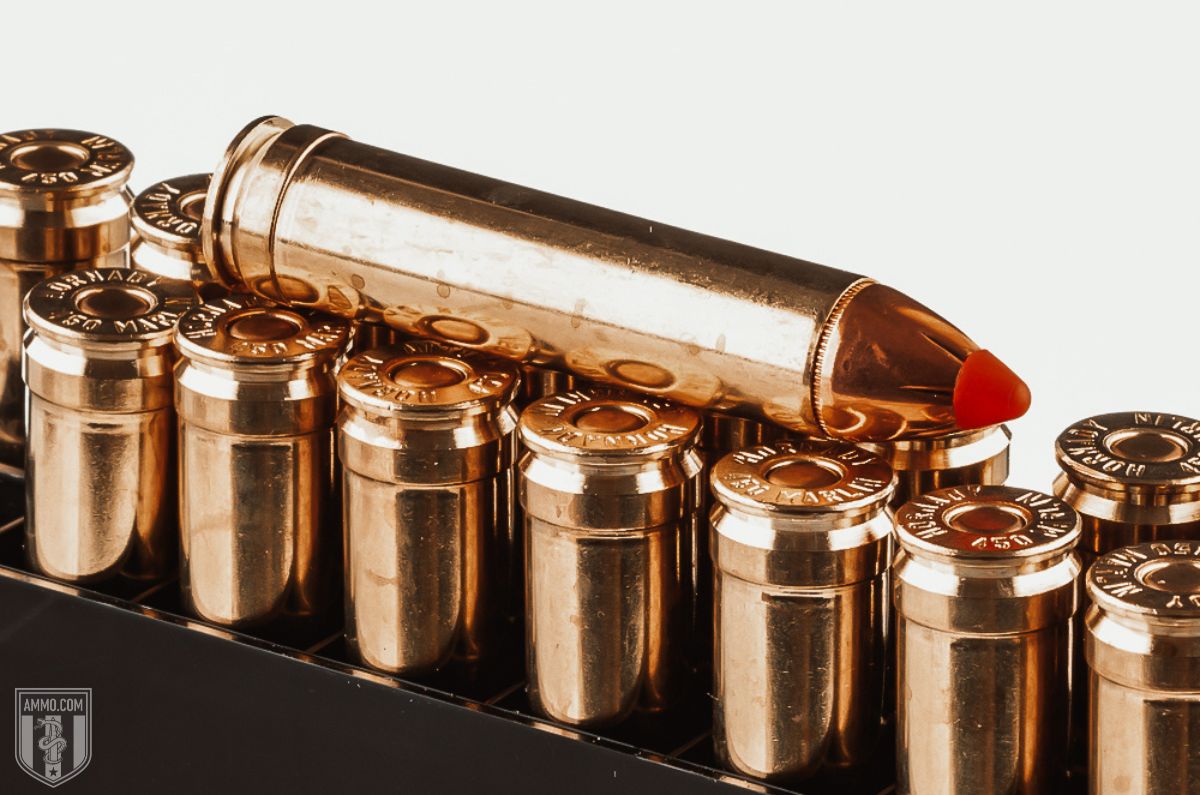
The advent of smokeless propellant allowed ballisticians to leverage the 45-70's massive case capacity like never before. Less smokeless propellant is needed to achieve the same ballistic result as black powder, which meant the 45-70 could be loaded to a far higher pressure than rifles chambered for it were designed to handle.
New 45-70 lever-action rifles, like the Winchester 1886 and Marlin 1895, were designed to accommodate modern 45-70’s loads’ stout pressure.
However, after WWII, the 45-70 had all but disappeared from the United States big game hunting scene, as all manufacturers had ceased producing rifles for it by the 1960s.
Marlin introduced the 444 Marlin to fill the need for a big bore hunting cartridge created by the 45-70’s leave of absence. Resembling a lengthened 44 Remington Magnum, the 444 Marlin achieved moderate success. If Marlin had any hope of the 444 Marlin becoming mainstream, then they squashed it by reigniting interest in the 45-70 during the 1970s, when they introduced a new line of lever-action rifles chambered for it. Cowboy Action Shooting enthusiasts soon grew to favor the 45-70, thus paving the way for its resurgence in popularity – and dooming the 444 Marlin to relative obscurity.
Cartridge Specs
When evaluating two centerfire cartridges, it’s good to begin by comparing their specs.
The 45-70 Govt has no parent case, and was a unique design when it was released in 1873. In contrast, the 450 Marlin draws its roots from the .458x2” American: a wildcat cartridge based on the 458 Winchester Magnum.
One striking difference between these two cartridges is that the 45-70 Gov has a rimmed case, whereas the 450 Marlin’s is belted. The 450 Marlin’s belt is a safety measure, as it prevents the round from being mistakenly chambered in incompatible 7mm Magnum or 338 Magnum firearms.
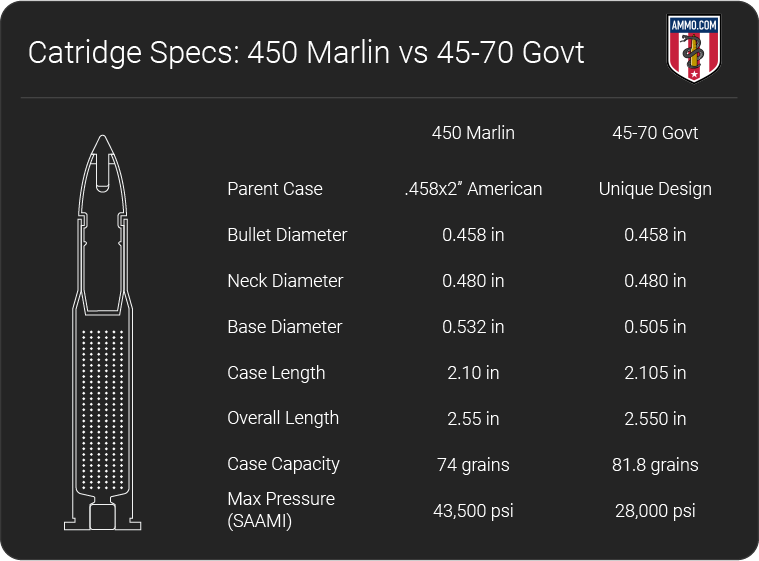
Its belted case helps the 450 Marlin ensure adequate headspace in bolt-action rifles. However, outside of a limited run of 450 Marlin Steyr Manlicher rifles, the 450 Marlin (and 45-70 too, for that matter) is predominantly chambered in lever guns (and, to a lesser extent, single-shot rifles).
Another major difference between these cartridges are their SAAMI specs the maximum safe chamber pressures. The 450 Marlin is rated at 43,500 psi: 55% higher than th 45-70’s 28,000 psi.
Those differences aside, the 45-70 and 450 are actually fairly similar.
Both rifle cartridges' case lengths are virtually identical. The 45-70 measures 2.10”;the 450 Marlin, 2.105”. Both rounds also share the same 2.55” overall length.
Both cartridges fire the same big bore 0.458” diameter bullets. There is a lot of bullet weight overlap between the two, with 325, 350, 405, and 500 grain bullets being the most common in factory loads. Either cartridge is capable of firing bullets weighing 200 to 500 grains.
The two rounds’ case capacities are also similar, with the 45-70 having a slight edge over the 450 Marlin: 81.8 grains H2O vs. 74 grains H2O, respectively.
Recoil
Recoil is an important consideration when purchasing a new rifle, as a round with heavy recoil will (A) be more difficult to control, and (B) slow the rate of accurate follow-up shots. Free recoil (an objective measure of recoil potency) is wholly determined by muzzle velocity (fps), powder charge weight, bullet weight, and firearm weight.
When loaded with 405 grain bullets, both cartridges generate around 33 ft-lbs of free recoil energy. Magnum loads by Buffalo Bore loaded with the same 405 grain bullet can produce around 47 ft-lbs of recoil, which approaches shoulder-bruising territory.
There’s no denying that these big bore cartridges have heavy recoil. Their massive powder charges and heavy bullets can be challenging for new shooters to control.
Due to its large case capacity, a wide variety of 45-70 factory loads are available to choose from. If you’re firing a Trapdoor, look for a reduced powder load that won’t destroy the rifle. If you’re firing a Marlin Model 1895 Guide Gun, then you’re at liberty to select one of the aforementioned “nuclear loads.” But whichever way you slice it, the 45-70 and 450 have strong recoil. Even “mild” factory loads deliver stout kicks.
Muzzle Velocity
From a ballistic standpoint, the 450 Marlin and 45-70 are virtually identical (so long as analogous loads are compared to one another).
We are somewhat limited on factory load options for 450 Marlin, as only Hornady and Buffalo Bore produce the ammo at the time of writing. For the purpose of this comparison we will compare Hornady LEVERevolution 450 Marlin 325gr FTX and Buffalo Bore 450 Marlin 405gr JFN.
Unlike the 450 Marlin, ample factory loads are available for 45-70. Such ammo loosely falls into three categories:
- Low pressure - Appropriate for the Trapdoor Springfield
- Mid pressure - For lever guns like a Winchester Model 1886 and Marlin Model 1895
- High pressure - For modern firearms designed to handle magnum loads
For the 45-70, we will evaluate Buffalo Bore’s low-pressure 500gr hard cast LFN, Hornady’s mid-pressure LEVERevolution 325gr FTX, and Buffalo Bore’s high-pressure 430gr LFN magnum load.
Note that Hornady’s two 325gr FTX loads give us a true “apples-to-apples” comparison of 450 Marlin vs. 45 70 ballistics.
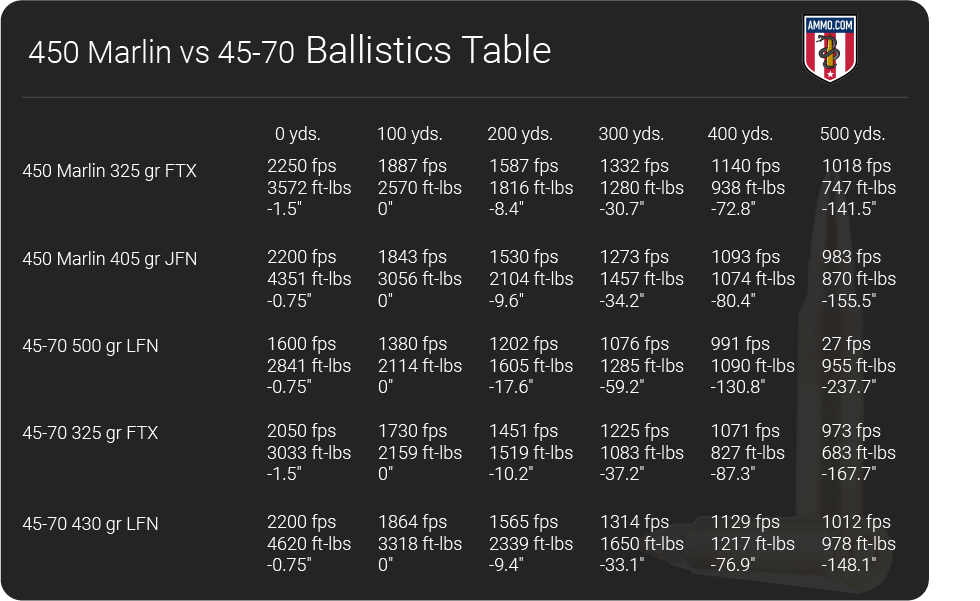
With the exception of the low-pressure load, all cartridges’ muzzle velocities exceed 2,000 fps. The 450 Marlin 325gr FTX load has the fastest muzzle velocity at 2,250 fps, while the 45-70 magnum load’s heavier 430gr bullet came in second at 2,200 fps.
Muzzle Energy
Muzzle energy is where these rounds really shine. The 45-70 and 450 Marlin are incredibly powerful rounds, with each factory load having more than 2,800 ft-lbs of energy. The Buffalo Bore 45-70 430gr load has the highest muzzle energy at a whopping 4,620 ft-lbs, while the 450 Marlin 405gr load comes in close second at 4,351 ft-lbs..
Trajectory
One shortcoming both cartridges share is their arching trajectory. This is not to say that you cannot shoot long-range with either round. It’s just more of a challenge.
The 450 Marlin 325gr FTX round has the flattest trajectory, with -141.5” of bullet drop at 500 yards (100-yard zero). That’s a steep fall off, but it’s nothing compared to the 45-70 500gr LFN’s -237.7” drop under the same conditions.
Why do these rounds exhibit such arching trajectories? It’s largely because their wide and not especially aerodynamic bullets hemorrhage momentum as they encounter frontal air resistance. What can we learn from this comparison?
The most illustrative data come from Hornady’s two 325gr FTX factory loads. The 450 Marlin’s muzzle velocity measures around 200 fps higher than the 45-70’s; its muzzle energy, around 500 ft-lbs higher.
This disparity stems from the higher chamber pressure the 450 Marlin is capable of handling. In general, 450 Marlin ballistics are marginally superior to those of the 45-70, though most hunters won’t notice any significant difference.
Ballistic Coefficient and Sectional Density
Ballistic coefficient (BC) reflects a bullet's aerodynamic properties, as well as its resistance to wind drift. Sectional density (SD) reflects a bullet’s ability to penetrate flesh.
If two 45-70 Govt and 450 Marlin rounds are firing the same bullet, then the higher (and better) BC will necessarily belong to the one with the higher muzzle velocity. Sectional density is solely determined by the bullet’s diameter and weight, meaning the two rounds’ potential for penetration is identical (noting that the harder-hitting of two otherwise identical bullets is inclined to penetrate more deeply).
Hunting
The 45-70 Government has been a staple in the big game hunting community for well over a century. It made a name for itself hunting whitetail, elk, and buffalo on the Great Plains, and can take down any animal in North America – or the world – with proper loads. The 450 Marlin is equally deadly on big game and has slightly improved ballistic performance.
The limiting factor for both rounds is their effective range.
With most varieties of factory ammo, whitetail or antelope can be safely taken within 400 yards, while elk or similarly sized big game must be taken within 200 yards.
Several other modern hunting cartridges offer double the effective range or farther. But the “cool factor” of hunting with lever guns is immeasurable. It’s more challenging, and offers hunters a connection to the past like no other rifle platform can.
Ammo and Rifle Cost/Availability
45-70 ammo and rifles are freely available. The 450 Marlin, on the other hand, is nearly a dead cartridge.
Ammo availability is a huge issue for the 450 Marlin, as only two companies make ammo for it at the time of writing: Hornady, and Buffalo Bore. In contrast, a large number of modern ammo manufacturers, such as Remington, Winchester, Federal, and Black Hills, make multiple varieties of 45-70 ammo.
When it comes to rifles, there are only two offerings for 450 Marlin on the market circa summer 2022: the Browning BLR, and the Winchester Model 94. In contrast, there is a wide variety of 45-70 lever-action rifles made by Marlin, Henry, Cimarron, Browning, Chiappa, Winchester, and more.
If you want the true cowboy experience – and you have the coin – then you’ll love one of Shiloh Sharps’ gorgeous 45-70 replica rifles. If you’re a handgun recoil junkie, then you’ll get a kick out of the Magnum Research BFR revolver which is available chambered for either round.
Some custom rifle manufacturers have taken a shine to the 45-70 and offer “tactical” lever guns. If you’ve ever wanted a 45-70 with an M-LOK rail, vertical grip, ported barrel, and red dot sight, you now can have it!
Reloading
Reloading is one method shooters use to reduce their ammo’s cost and increase its consistency. Better yet, handloads can be tailored to meet your and your rifle’s specific needs.
Reloading is where the 45-70's versatility really shines. You can easily create low-pressure rounds for plinking, as well as perfect the high-pressure loads you need for hunting with modern 45-70 rifles.
Sourcing components for 45-70 is relatively simple, as multiple manufacturers make brass and 0.458” diameter bullets for the round. Although the 450 Marlin does use the same bullets, its brass is extremely difficult to find. Hornady is currently the only company making factory-new cases.
Final Shots: 45-70 vs 450 Marlin
The 45-70 Government and the 450 Marlin are two centerfire big bore cartridges that excel at big game hunting. Capable of delivering massive slugs onto targets at ranges up 400 yards, both rounds are effective against any North American game.
Although the 450 Marlin is slightly superior to the 45-70 in terms of ballistics, many shooters see it as an answer to a question that was never asked.
Most shooters opt for the 45-70, which I recommend doing. While it may not be as plentiful as 223 Remington or 308 Win, there are considerably more 45-70 options available than there are 450 Marlin.
If you own an older 450 Marlin rifle, there’s no need to get rid of it. Just invest in a good reloading setup and enjoy firing a cartridge that offers just as much flexibility as the 45-70.
No matter which cartridge you choose, be sure to stock up on ammunition here at Ammo.com.
I’ll see you on the range!
Ammo Comparisons
- .308 vs 5.56
- 6.5 Creedmoor vs .308
- .300 Blackout vs .308
- .300 Win Mag vs .308
- .243 vs .308
- .308 vs .30-06
- 7mm-08 vs .308
- .270 vs .308
- 7.62x39 vs .308
- .223 vs .308
- .338 Lapua vs .308
- .380 ACP vs 9mm
- .223 vs 5.56
- .300 Blackout vs 5.56
- 9mm vs 45 ACP
- 9mm vs 40 S&W
- .357 SIG vs 9mm
- 10mm vs 9mm
- 9mm vs 9mm Luger
- .243 vs .270
- .300 Win Mag vs .30-06
- .270 vs .30-06
- .40 vs .45
- 38 Special vs 357
- 9mm vs 40 vs 45
- 5.56 vs 7.62x39
- 338 Lapua vs .30-06
- .30-30 vs .30-06
- 300 PRC vs 338 Lapua
- .30-06 vs 7mm
- 300 Win Mag vs 338 Lapua
- 300 PRC vs 300 Win Mag
- 300 WSM vs 300 Win Mag
- 338 Win Mag vs 338 Lapua
- 12 Gauge vs 20 Gauge
- 10mm vs 357 Mag
- .30-30 vs 7.62x39
- 224 Valkyrie vs 22-250
- 17 HMR vs 22 Mag
- 7.62x39 vs .300 Blackout
- 45 ACP vs 45 Auto
- 45-70 vs 30-30
- 300 Blackout vs 223
- 357 Magnum vs 9mm
- 350 Legend vs 300 Blackout
- 224 Valkyrie vs 223
- 45 ACP vs 38 Super
- 6.5 Grendel vs .308
- 17 HMR vs 22 LR
- 10 Gauge vs 12 Gauge
- 22-250 vs 223
- 45 Colt vs 45 ACP
- 350 Legend vs 30-30
- 5.7x28 vs 223
- 5.7 vs 9mm
- 5.56 vs 5.7
- 22 vs 9mm
- Buckshot vs Birdshot
- 450 Bushmaster vs 308
- 450 Bushmaster vs 223
- Buckshot vs Slug
- 6.5 Grendel vs 5.56 vs 223
- 6mm ARC vs 6.5 Grendel
- 44 vs 45
- 458 SOCOM vs 5.56
- 357 vs 44
- 32 ACP vs 380
- 300 Win Mag vs 338 Win Mag vs 338 Lapua Mag
- 450 Bushmaster vs 458 SOCOM vs 50 Beowulf
- 6mm Creedmoor vs 6.5 Creedmoor
- TMJ vs FMJ
- 44 Special Vs 44 Magnum
- 45 90 vs 45 70
- 6.8 Western vs 6.8 SPC
- 50 Beowulf vs 50 BMG
- 26 Nosler vs 6.5 PRC
- 28 Gauge vs 410
- 6.8 SPC vs 5.56
- 6.8 SPC vs 6.5 Grendel
- 6.8 Western vs 7mm Rem Mag vs .28 Nosler
- 6.8 Western vs 6.5 Creedmoor
- 22 Hornet vs 223
- 6.8 Western vs 6.5 PRC
- .410 vs 12 Gauge
- .410 vs 20 Gauge
- 22 LR vs 22 Mag
- 6mm ARC vs 243
- 7mm-08 vs 270
- 243 vs 6.5 Creedmoor
- Nickel vs Brass Casing
- 204 Ruger vs 223
- 50 Beowulf vs 5.56
- 260 Remington vs 6.5 Creedmoor
- 6mm Remington vs 243
- 28 Nosler vs 300 PRC
- 50 Beowulf vs 50 AE
- 22 Nosler vs 22-250
- 450 Marlin vs 45-70
- 300 Win Mag vs 300 Norma
- 458 SOCOM vs 300 Blackout
- 38-55 vs 45-70
- 22 Hornet vs 22 LR
- 300 Norma vs 338 Lapua
- 338 Lapua vs 50 BMG
- 28 Nosler vs 300 Win Mag
- 28 Nosler vs 6.5 Creedmoor
- 204 vs 22-250
- 458 SOCOM vs 45 70
- 44 40 vs 45 70
- 6.8 SPC vs 6.5 Creedmoor
- 450 Bushmaster vs 30-06
- 7mm Rem Mag vs 300 Win Mag
- 30 Carbine vs 223
- 25-06 vs 30-06
- 26 Nosler vs 28 Nosler
- 16ga vs 12ga
- 30 06 vs 7.62 x54R
- 9mm Makarov vs 9mm Luger
- 350 Legend vs 223
- 30 Carbine vs 5.56
- 6.5x55 vs 6.5 Creedmoor
- 6.5 Creedmoor vs 270 vs 25-06
- M193 vs M855
- 450 Bushmaster vs 458 SOCOM
- 6.5 Grendel vs 6.5 Creedmoor
- 350 Legend vs 5.56
- .277 Fury vs 6.8 SPC
- 277 Fury vs 300 Win Mag
- 10mm vs .45 ACP
- 277 Fury vs 223
- 6.8 SPC vs 300 Blackout
- 6.5 PRC vs 6.5 Creedmoor
- 277 Fury vs 308
- 277 Fury vs 6.5 Creedmoor
- 350 Legend vs 450 Bushmaster
- 277 Fury Vs 5.56 NATO
- 10mm vs 40S&W
- 32 ACP vs 9mm
- 32 Special vs 9mm
- 8.6 Blackout vs 300 Blackout
- 30 Super Carry vs. 9mm
- 5.56 vs 9mm
- .50 Action Express vs 9mm
- 7.62x25 vs. 9mm
- 10mm vs 44 Magnum
- 300 Blackout vs 300 Win Mag
- 6.5 Grendel vs 300 Blackout
- 460 Rowland vs 10mm
- 300 RUM vs 300 PRC
- 300 Norma vs 300 PRC
- 45 GAP vs 45 ACP
- 7mm PRC vs 300 Win Mag
- 300 PRC vs 6.5 Creedmoor
- 300 PRC vs 308
- 357 SIG vs 357 Mag
- 7.62x39 vs 7.62x51
- 243 Win vs 223 Rem
- 30 Nosler vs 300 PRC
- 6.5 Creedmoor vs. 30-06 Springfield
- 450 S&W vs. 44 Magnum
- 6.5 Creedmoor vs. 300 Win Mag
- 454 Cassull vs. 45-70 Govt
- 454 Cassull vs. 44 Mag
- 7.62x54r vs. 308 Winchester
- 22 ARC vs. 223 Rem
- Subsonic vs. Supersonic Ammo
